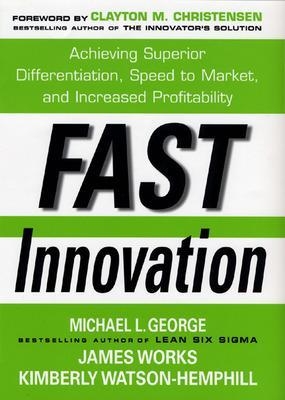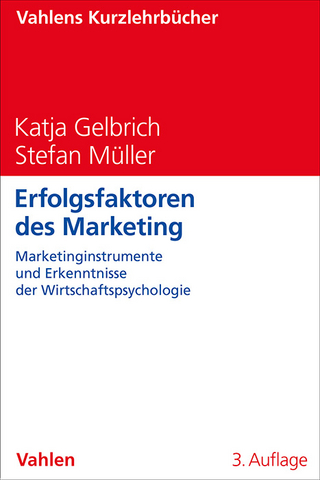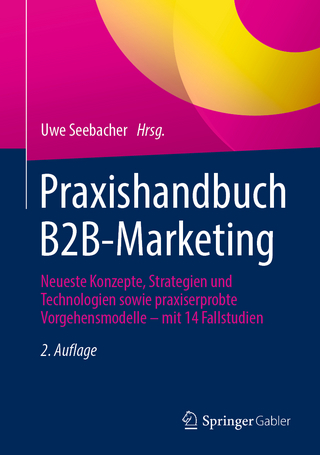
Fast Innovation: Achieving Superior Differentiation, Speed to Market, and Increased Profitability
McGraw-Hill Professional (Verlag)
978-0-07-145789-7 (ISBN)
- Titel z.Zt. nicht lieferbar
- Versandkostenfrei innerhalb Deutschlands
- Auch auf Rechnung
- Verfügbarkeit in der Filiale vor Ort prüfen
- Artikel merken
Surveys by the Economist and many others show that the top of mind issue for most CEO and managers has shifted from cost reduction to revenue growth. As the world economy shifts from one of contraction to expansion, companies know that revenue growth is strictly dependent on their innovation process. For the majority of companies, more than 25% of this year’s revenue are for products and services that did not exist 3 years ago. Moreover, the life-cycle of offerings is growing ever shorter. Sixty percent of companies report that their growth is hampered because the lead time of their innovation process takes too long and costs too much.Companies understand the causes of long lead time and high cost in manufacturing, and its remedy using the Lean methodology. However, the causes of long lead time and high cost in innovation are not understood, nor is their remedy. This book, for the first time, explains the causes of long lead time and ineffective innovation, and provides a proven solution.Conquering the Growth Challenge explains why it takes so long for innovations to reach the market and why they so often fail; and provides solutions for how to reduce time-to market and increase the success rate. It provides the complete foundation for reducing time-to-market of successful innovative offerings, applicable to any business, and is the first to provide quantitative links such that a thoughtful CEO or manager who implements the Fast Innovation process featured in this book can launch a new innovation, confident that it will meet its required delivery date. The solutions discussed in this book have already been applied in varying degrees by firms such as GE, 3M, Toyota and Microsoft.In short, what you’ll get in this book is an answer to the challenge every company faces: how can we increase differentiation and competitive advantage while shortening time-to-market? At first glance, that sounds like an impossible goal because increased differentiation was historically accompanied by increased organisational and offering complexity—which often served to clog development pipelines. George provides the necessary implementation infrastructure and tools to achieve:•Significantly faster and controllable time-to-market•A highly differentiated product, service or experience•Low cost of complexity and low cost operations •Fast operational lead times
McGraw-Hill authors represent the leading experts in their fields and are dedicated to improving the lives, careers, and interests of readers worldwide McGraw-Hill authors represent the leading experts in their fields and are dedicated to improving the lives, careers, and interests of readers worldwide McGraw-Hill authors represent the leading experts in their fields and are dedicated to improving the lives, careers, and interests of readers worldwide McGraw-Hill authors represent the leading experts in their fields and are dedicated to improving the lives, careers, and interests of readers worldwide.
Part I: An Executive’s Guide to Fast Innovation
Chapter 1 Using Fast Innovation to Drive Organic Growth
Innovation’s Contribution to Organic Growth and Value Creation
The Challenges of Sustained Growth
The Fast Innovation Value Proposition
Conclusion
Chapter 2 The Three Innovation Imperatives: Differentiated, Fast, Disruptive
Imperative #1: Differentiation
Imperative #2: Fast Time-to-Market
Imperative #3: Disruption
The Power of Disruptive Innovation
The Most Important Disruptive Innovation of the 20th Century
Joining the Winning 10%: Being disruptive (even if based on sustaining innovations)
Conclusion
Spotlight On: Customers and Differentiation
Understanding the Heart of the Customer
Strategy #1: Develop strong links to both the core and fringes of your market
Strategy #2: Use ethnography to understand customer needs better than anyone else
What’s Really Different?
A Look Ahead
Chapter 3 How to Become Fast
Prerequisite 1: Attacking the biggest drivers of innovation lead time
The Law of Lead Time
The Astounding Impact of Variation
The Sources of Project Delays
Meeting Project Schedules Despite Task-Time Variation
Pre-requisite 2: Rapid Cycles of Learning Creates Differentiation
A. Ethnography:
B. Rapid Prototyping
C. The Innovation Blitz
D. Flexible Performance Target Design
Conclusion
Chapter 4 The Value of Thinking in Three Dimensions
Dimension 1: New Product/Service Innovation
Dimension 2: Market Definition Innovation
Dimension 3: Process/Business Model Innovation
The Strong Advantage of Multidimensional Innovation
Conclusion
Chapter 5 Open Innovation: Applying the Intellect of the Planet
A Quick Look at the Closed Innovation Model
Open Innovation Model
Open Innovation Case #1: Eli Lilly’s web-based InnoCentive
Open Innovation Case #2: Procter & Gamble
Open Innovation Case #3: Intel’s problem that required thousands of innovators
The Future of “R” in Corporate R&D?
Conclusion
Chapter 6 The Religion of Re-use
Why Re-use?: To become faster and more differentiated
Platforms and Operating Cost Efficiency: An organizing principle for re-use
Overcoming Resistance to Re-use: A case study
Using “External” Platforms to Capture Customers
Conclusion
Spotlight On: Leading Innovation
Disruptive Innovations Where CEO Presence Was Necessary
Characteristics of an Innovation-Enabling Executive
Defining the Burning Platform
RECAP of Fast Innovation
Part II: Building Corporate Innovation Capacity
Introduction to Part II
Chapter 7 Foundations of an Innovation Factory
Foundation #1: Leadership courage and engagement
Building Leadership Engagement
How to get there: The executive retreat
Foundation #2: Business units capable of meeting the demands of Fast Innovation
1. Design/development groups (R&D)
2. Marketing/Strategy
3. Sales/Service
4. Operations
5. Finance
Foundation #3: Superior execution capability to deliver innovations
Conclusion
Spotlight On: Conquering the Cost of Complexity
The (Often Hidden) Impact of Complexity
Conquering Complexity Accelerates Innovation
Attacking Complexity
Chapter 8 The Executive Engine of Fast Innovation: Using a Chief Innovation Officer to Drive Results
The Responsibilities of the Chief Innovation Officer
Defining Innovation Goals and Metrics
Funding Disruptive Innovation: Real Options Theory
Real Options Theory
Conclusion
Chapter 9 Becoming Customer Driven
Using Customer Knowledge Throughout the Design Process
A Case Study in VOC
VOC Translation Tools (Design for Lean Six Sigma)
Increasing Trust in Your VOC
Conclusion
Spotlight On: Creating an Idea-Rich Environment
1. Raise awareness of innovation opportunities
2. Create an Idea Forum
Chapter 10 Fast and Flexible: The New Corporate Mantra for Design Work
Flexible Performance Targets: How to be creative without sacrificing lead time
Designing to Flexible Performance Targets
Conclusion
Chapter 11 Institutionalizing Re-use
The Many Faces of Re-use
Re-use and Innovation by Analogy
Re-use and Best Practices
Re-use and Channels
Re-use and Intangible Products
Re-use Resistance (and How to Overcome It)
Argument #1: Developing re-usable designs is too expensive
Argument #2: “I’m a creator, not a re-user”
Other Ways to Facilitate Re-use
Conclusion
Part II Conclusion
Part III Deploying Fast Innovation Projects
Introduction to Part III
Chapter 12 Project Screening and Selection
Identifying Opportunities
Managing Sustaining vs. Disruptive Evaluation Processes
Screening Ideas at the Business Unit Level
Screen #1: Rough “go/no-go” filter
Screen #2: Composite scores on attractiveness and effort
Screen #3: Business case development and project selection
Hold Off on That Launch!
Chapter 13 Increasing Innovation Capacity Without Adding Resources
Gathering the Necessary Data
Step 1: Categorize your developers’ activities
Step 2: Gather time data
Optimizing Utilization: A case study
Multi-Tasking Harms Creativity
Attacking the Causes of Multi-tasking
Conclusion
Spotlight On: The Innovation Blitz
Traditional vs. Blitz Model: Trench warfare vs. a lightning attack?
Using the Blitz approach
Chapter 14 The FastGate Method: How to Control Innovation Lead Time
FastGate, Feedback and Critical Resources
The FastGate Method for Innovation Project Management
Making the Initial Adjustments
Ongoing Use of FastGate Reviews
Tracking Project Performance
Oregon Productivity Matrix
Conclusion
Chapter 15 Creating Innovation Incubators: How to Catalyze Creativity on Your Teams
Becoming a Catalyst for Creativity
1. Immerse team members in customer knowledge and other background
2. Make the problem difficult and specific
3. Push the boundaries in brainstorming
4. Help (or even force) people to think in new ways
5. Look at the whole value stream; keep their minds open to all steps
6. Allow space for thinking/ruminating
Conclusion
Recap of Part III
Appendix 1: The Impact of Task Variation and Utilization on Lead Time
Appendix 2: Time Buffers and Feedback Systems
Appendix 3: Innovation and Information Creation
Index
| Erscheint lt. Verlag | 16.7.2005 |
|---|---|
| Sprache | englisch |
| Maße | 231 x 236 mm |
| Gewicht | 637 g |
| Themenwelt | Wirtschaft ► Allgemeines / Lexika |
| Wirtschaft ► Betriebswirtschaft / Management ► Marketing / Vertrieb | |
| ISBN-10 | 0-07-145789-5 / 0071457895 |
| ISBN-13 | 978-0-07-145789-7 / 9780071457897 |
| Zustand | Neuware |
| Haben Sie eine Frage zum Produkt? |
aus dem Bereich


